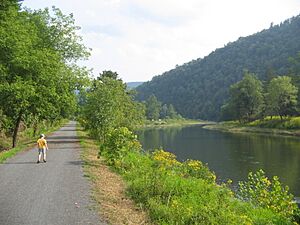Pine Creek Path facts for kids
The Pine Creek Path was an important trail used by Native Americans in Pennsylvania. It stretched a long way, following Pine Creek from the West Branch Susquehanna River in the south all the way north to the start of the Genesee River. Today, the town of Jersey Shore is near its southern end. This path was like an ancient highway, connecting different places and people.

The Path's Route
The Pine Creek Path started in the south near what is now Jersey Shore. Here, a Native American village once stood. Another important trail, the Great Shamokin Path, crossed here. It ran east and west along the West Branch Susquehanna River.
The Great Shamokin Path connected villages like Shamokin (now Sunbury) in the east. It also linked to places further west, like Lock Haven, Clearfield, and Kittanning. To the north, the Pine Creek Path continued along the Genesee River. This northern part led to the Iroquois Nation in New York State.
The main Pine Creek Path followed Pine Creek as it went north. It sometimes switched from one side of the creek to the other. It passed through a beautiful area called the Pine Creek Gorge. This gorge is sometimes called the "Grand Canyon of Pennsylvania."
The path stayed on the left side of the creek after reaching a spot called the First Fork (now Little Pine Creek near Waterville). It continued past the Second Fork (now Babb Creek at Blackwell). Then it reached the Third Fork (now Marsh Creek) near the village of Ansonia.
From Ansonia, the path left the gorge and turned west. It went past modern Galeton to West Pike. There, it left the creek and headed north towards the Genesee River. The exact route between West Pike and the Genesee River's start is not fully known.
There was also another branch of the path in the south. This alternate route went north from the West Branch Susquehanna River. It followed Chatham Run, passing near modern Woolrich. This branch then joined the main path near Waterville.
How the Path Was Used
The Pine Creek Path was used for many purposes over time. Iroquois warriors traveled on it during their war expeditions to the south. It was a key route for movement and communication.
One of the earliest stories about the path comes from Moses Van Campen. He was captured in 1782 and taken north as a prisoner along this very path. Some small groups of Native Americans continued to live in the Pine Creek Gorge until the War of 1812.
Later, in the 1800s, logging became a big business along Pine Creek. Lumbermen used the path often. They would float rafts of cut timber down Pine Creek from Ansonia to Jersey Shore in the spring. After delivering the lumber, they would walk back north along the path to get more.
Early attempts to turn the path into a wagon road were not very successful. John Peet tried it and said it took him 18 days. He had to cross Pine Creek "eighty times" each way. His wagon lost a wheel, broke two axles, and tipped over twice!
In 1883, a railroad called the Jersey Shore, Pine Creek and Buffalo Railway was built. It followed the same route as the old path from Jersey Shore to Ansonia. This railroad later became part of the New York Central Railroad.
The railroad line was eventually taken over by Conrail in 1976. However, the last train ran on this route on October 7, 1988. After the tracks were removed, the old railroad path was turned into the Pine Creek Rail Trail. In 2001, a USA Today article even called it one of the "10 great places to take a bike tour" in the world!

